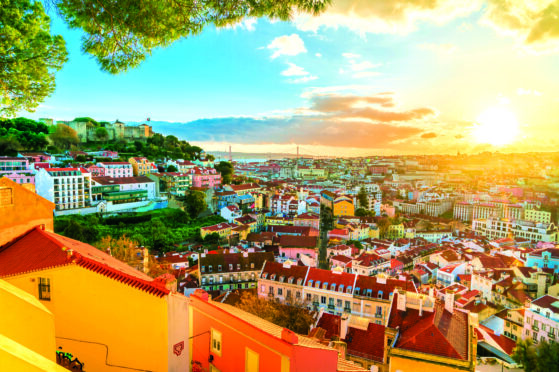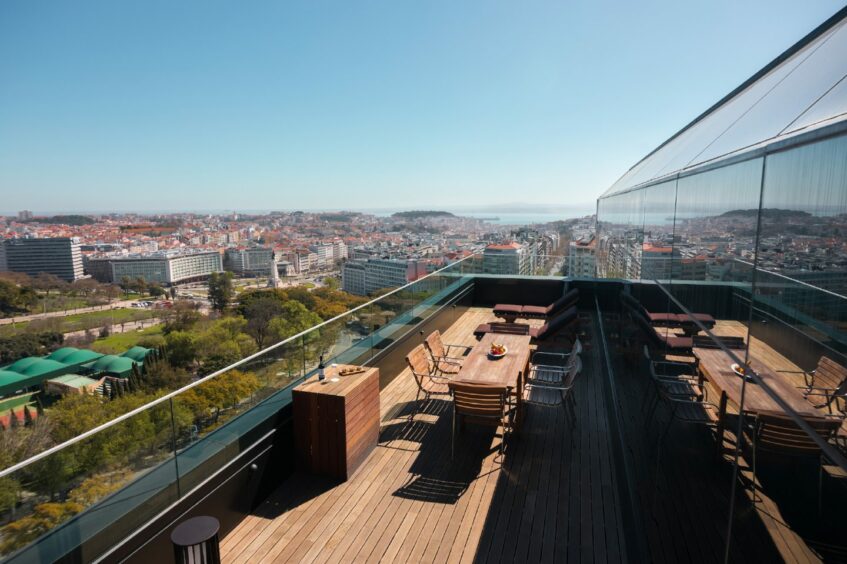
From my bedroom on the 16th floor of the InterContinental hotel in Lisbon, I can survey the entire magnificent city, from the crenellated might of Sao Jorge’s Castle to the gigantic clifftop statue of Christ the King.
From this vertiginous position in the hilltop hotel, which towers over the city like a majestic ship, I feel like the Master and Commander of Lisbon.
This hotel in the shape of an imperious ocean-going liner chimes with the rich, sea-faring history of the city. Lisbon led the world in its golden Age of Discoveries during the 15th and 16th centuries when explorers such as Prince Henry the Navigator, Vasco Da Gama and Ferdinand Magellan transformed the world by finding new sea routes to Asia, Africa and South America.
Their pioneering explorations are celebrated both in Sao Jeronimo’s Monastery, a dazzling UNESCO World Heritage site built in the Belem district during the 1500s to commemorate Vasco Da Gama’s discovery of India, and in the impressive Monument to the Discoveries. This was constructed in 1960 on the bank of the River Tagus in the form of a ship’s prow to mark the 500th anniversary of Henry’s death.
The InterContinental also echoes another major theme that runs through the city: the gorgeous Moorish tiles that bedeck just about every spare surface in Lisbon. From the breakfast room to the lobby, eye-catching tiles are dotted throughout the hotel. For instance, when you get out of the lift, the number of each floor is etched out in elegant, multi-coloured tiles.

Akla, the hotel’s excellent restaurant, is also decorated with some exquisite tiles. In the dining room, one collection of tiles depicts the alluring scene of 16th Century fishermen preparing to board a long boat.
Maybe they are setting out to catch the sort of scrumptious fish that adorn the plates in Akla. The wonderful shrimp “Pica Pau” with garlic and piri-piri comes highly recommended.
The InterContinental is an excellent place from which to investigate the many joys of the city, including its spectacular street art. After the revolution on 25 April 1974, the Portuguese were determined to express an artistic spirit that had been suppressed for far too long.
After initial official disapproval, street art is now encouraged and even sponsored by the local council in places such as the open-air gallery on Avenida Conselheiro Fernando de Souza. There one graffiti artist has spelled out the credo that they all adhere to: “Paint the universe. Do what you love.”
Street art explodes like an eruption of creativity from every nook and cranny of the city.
It’s as if Lisbon has taken heed of the British art shops called Let’s Fill This Town with Artists!
Turn one corner and you are blown away by a compelling mural of David Bowie with a finger to his lips amid a flock of adoring hummingbirds. Turn the next and you are enthralled by a two-storey high painting of Frieda Kahlo. Her face comprises entirely of a patchwork of mirrors, implying perhaps that we are all reflected in the revolutionary Mexican artist.
The street art hits you when you least expect it. For example, on the wall of the Calçada da Glória, for no discernible reason a mournful face attempts to burst out of a street corner, as if trying to escape from another, more doleful realm. Some of the street art is avowedly political. On the Calçada de Santa Apolónia, there is a huge mural of a smiling woman watering a window-box full of blooming sunflowers. But there is more to it than meets the eye. It was painted to honour the 150th anniversary of the abolition of the death penalty in Portugal, and its message is a defiant celebration of life.
Those are just a few examples, but throughout the city there are more wondrous pieces of street art than you can shake a selfie stick at. Contemporary art sits very comfortably next to the more historic treasures in Lisbon – and boy, does Lisbon have a lot of historic treasures. The ruined convent of the Largo de Carmo, in the delightfully bohemian Bairro Alto district of the city, for instance, takes your breath away.
It was built in 1389, before being partially destroyed by a devastating earthquake in 1755. All that is now left of the convent are the outer walls and the internal Gothic arches, which look stunning silhouetted against the blue, blue sky.

The sturdy Church of Sao Roque nearby is very much still standing. In 1749, King Joao V asked the papal architect to build this church in Rome. It was then disassembled and transported piece by painstaking piece to Lisbon. So complex was its interior of ivory inlay, lapis lazuli, highly detailed mosaics of St John the Baptist and more gold than Spandau Ballet that the church took four years to reconstruct in Portugal.
The edifice seems to live up to the old adage that the more expensive and difficult it is to build, the more it proves your devotion. By the way, in case you’re wondering – and I’m sure you are – Sao Roque is the patron saint of knee problems, skin disorders, diseased cattle, the falsely accused, grave-diggers, and dog owners, but curiously not pebbles, stones or boulders.
It is impossible not to be captivated by Lisbon’s lived-in, vivacious charms. The city is an enchanting maze of higgledy-piggledy cobbled backstreets in which it is a delight to get lost. It is equally joyous to ride Lisbon’s seven, often alarmingly steep hills in a rattly old vintage tram. As I depart for the airport, I notice a restaurant on a corner near the InterContinental. It’s called “Sublime Lisbon.”
I can’t think of a more appropriate summary.
Factfile
The InterContinental Lisbon costs from £210 per night. www.iclisbonhotel.com
Flights to Lisbon: ryanair.com

Enjoy the convenience of having The Sunday Post delivered as a digital ePaper straight to your smartphone, tablet or computer.
Subscribe for only £5.49 a month and enjoy all the benefits of the printed paper as a digital replica.
Subscribe